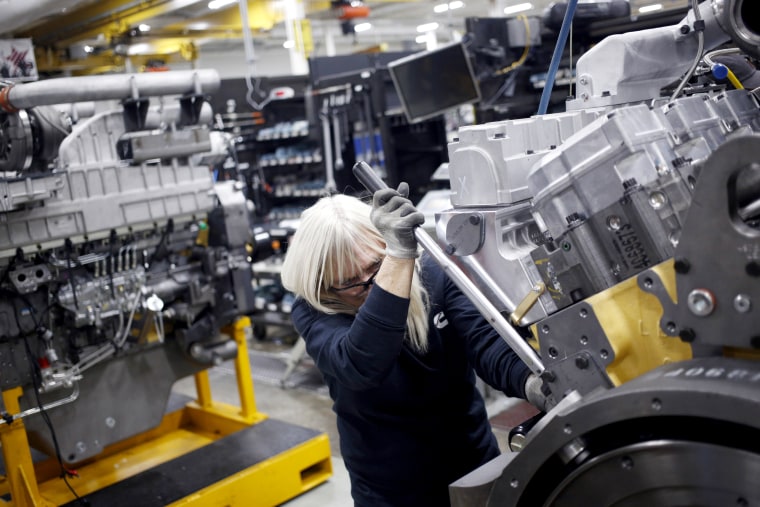The White House insisted that tariffs would be a boon to U.S. factories. The Federal Reserve says otherwise.
A new report from the Fed’s Divisions of Research & Statistics and Monetary Affairs, titled “Disentangling the Effects of the 2018-2019 Tariffs on a Globally Connected U.S. Manufacturing Sector,” concluded that President Donald Trump's tariffs led to job losses in the manufacturing sector and higher prices for producers and consumers.
“Our results indicate that tariffs have been a drag on employment and have failed to increase output,” authors Aaron Flaaen and Justin Pierce wrote. A key production benchmark published earlier this month found that U.S. manufacturing shrank for the fourth straight month in November.
The two researchers studied the effects of what they characterized as “unprecedented tariff increases” implemented over the past two years on American manufacturers. “There are virtually no modern episodes of a large, advanced economy raising tariffs in a way comparable to the U.S. in 2018-2019,” they noted.
Previous research conducted by a wide swath of agencies and private-sector firms has documented the broader harmful economic impact of protectionist trade policies espoused by the Trump administration. For instance, research conducted jointly by the Federal Reserve Bank of New York, Princeton University and Columbia University found that the tariffs implemented in 2018 alone cost Americans a collective $1.4 billion each month.
Tariff proponents — up to and including the president — argue that making imported raw materials and finished goods more expensive will drive production back to the U.S. In reality, the Fed new report found, the complexity and global scope of today’s industrial supply chains make it nearly impossible for multinational manufacturers to respond this way.
“What you’re trying to do is roll back 50 or 60 years of progressive trade liberalization,” said Jacob Kirkegaard, senior fellow at the Peterson Institute for International Economics. “These were linkages that didn’t exist back in the 1950s… Undoing that is very, very economically dangerous.”
One of the biggest casualties has been manufacturing jobs. The labor market advantage conferred by protectionism was more than outweighed by the combination of higher input costs and retaliatory tariffs, Flaaen and Pierce said.
Their research found “a negative and statistically significant relationship between the rising input cost effect of tariffs and manufacturing employment… [and] a negative effect of foreign retaliatory tariffs on U.S. manufacturing employment that is apparent immediately after retaliatory tariffs begin to be imposed.”
Most of the Trump administration’s tariffs have been imposed on China; accordingly, the report found that manufacturers with a greater presence in or exposure to the Chinese market were more negatively impacted.
Some American manufacturers were able to boost their domestic market share, but the trade-off was higher production costs, since tariffs were applied on many foreign-made industrial inputs and raw materials, as well as reduced competitiveness in foreign markets.
“Tariffs can have impacts through channels beyond their traditional effect of limiting import competition,” Flaaen and Pierce said.
Domestic buyers, whether they are other companies or retail consumers, wind up paying more in two ways: Higher input costs get passed through the supply chain, and a reduction in foreign competition prompts American companies to raise prices. An earlier study found that a 20 percent tariff on imported washing machines imposed in January 2018 led to an average rise of 12 percent in retail prices — or nearly $100 per machine, and big appliance brands raised prices for clothes dryers in tandem with the washing machine price hikes, even though dryers were not included in the tariff.
Tariffs have made American-made products more expensive — and less competitive — overseas in two ways. Higher input costs played a role here, as did the tit-for-tat retaliatory tariffs imposed in response by other countries.
The Fed report acknowledged that these short-term effects aren’t necessarily permanent — but they added that there also could be as-yet-unknown long-term ramifications, as well.
If companies believed tariffs were in place in perpetuity, they might reconfigure their supply chains rather than continuing to incur higher expenses. Due to the decades-long supply chain optimization process multinational manufacturers have developed, though, any such changes would take considerable time and expense to implement. For instance, some industrial inputs such as certain smartphone parts or computer components are only produced in China. There is no trained labor supply or ready access to raw materials anywhere else around the globe.
The new Fed report also said it “does not explicitly consider the effects of increased uncertainty about future trade policy.” Economists blame that uncertainty for a sharp decline in corporate capital investment, even though companies were left flush with cash after the 2017 tax cut.
“It’s very clear that when executives are faced with tariffs, they don’t invest,” Kirkegaard said, noting that manufacturing employment growth has lagged behind the broader economy to a significant degree since the tariff war began.
This new report shows that Trump and his advisers are out of touch with the modern economy, Kirkegaard added.
“The core economic thinking of the administration is out of the 1950s. It doesn’t reflect the interconnected world,” he said. “The world is more complicated than it was in the 1950s, and consequently, when you impose tariffs on an industry that has lots of international connections, it’s going to backfire.”
